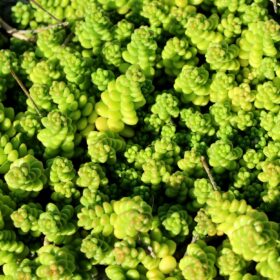IDENTIFICATION
Scientific name:
Sedum spp. (spp= nelle varie specie)
Italian common name:
Sedum. Sedum plants are popularly known by their common names. For example, Sedum acre is called borracina acre, Sedum sieboldii is known as Japanese crassula or teresina grass while Sedum telephium is called Callus grass, Borracina massimo or, more frequently, Madonna’s grass
Family:
Crassulaceae
Origin:
native to the cold and temperate areas of Eurasia. It is found practically everywhere except Australia and Polynesia.
Environment:
Several species grow wild on walls and in rock gardens.
Evergreen or deciduous:
Deciduous or evergreen depending on the species
Toxicity:
not
PLANT RECOGNITION
Height:
10 -15 cm, there are shrubby species that can reach 90 cm

Width (extension):
40 – 60 cm.
Habit:
Sedums have very varied growth habits: creeping, bushy and grassy like the acre sedum which does not exceed 10 cm in height or more imposing like the notable spectabile sedum.
Leaf:
persistent, oval, arranged in a rosette to form a sort of star. The leaves are fleshy and generally light green but in winter they often have red margins.
Flower:
small in size, they can be solitary or gathered in cluster, panicle or corymb inflorescences. They have a star or bell shape. The colors vary from cream-white to intense yellow, from pink to red-purple to violet.
Flowering:
May – September
Fruit:
insignificant
Stem:
both erect and hanging, almost always in tufts
Property:
Its species are all highly appreciated in herbal medicine and in the field of natural medicine. In fact, they contain substances that give different properties: healing, astringent, emollient, painkiller.
The fresh leaves are used externally as: natural anti-inflammatories, for example to soothe sores or ulcers of the skin or oral mucosa, healing, soothing in case of burns, erythema (including sunburn), cysts, mastitis. Furthermore, its application at a topical level would favor the escape of foreign bodies stuck under the skin, such as splinters of iron or wood.
Parfume:
light
NEED
Maintenance:
Simple. They are considered “hardy” and “semi-hardy” plants because they also tolerate low temperatures and sometimes even frost.
Light Exposure:
half shade. Sun only with temperatures between 18 and 20°
Soil type:
chalky, fertile, sandy
Soil acidity:
slightly acidic or neutral. pH 6 – 7,5
Italian climatic area:
it survives between -10° and 40 °C in the North and Apennines, Central, South and islands. The rustic species are grown outdoors throughout Italy, with the exception of the alpine species which are not suitable for hot climates, while the semi-rustic ones must be sheltered in winter, even if they tolerate temperatures below zero.
Need for water:
in summer it should be watered regularly, but waiting until the soil is completely dry, while between autumn and spring it is best to water only if the leaves lose their turgidity
Propagation:
Seed, cutting: should be carried out between May and June. Proceed by cutting some apical parts of the stem approximately 5 cm long with sharp and disinfected shears. After drying them for a couple of days in the open air, they are buried in specific soil.
Division by tufts: one or more parts with their roots must be detached from the mother stock, and then planted immediately. In this case, operate between October and March.
Pruning:
as the leaves dry out or show damage, they must be eliminated immediately to prevent them from carrying parasitic diseases.
Illnesses:
aphids / mealybug
Cultivation:
Easy even if very slow.
PARTICULARITY
The name of the Sedum genus was defined by Linnaeus and could derive from the verb “sedeo” or “I sit” due to the prostrate posture of numerous varieties of these plants, or from “sedate”, “calm” in reference to some properties of the sedum .
Annotations

Genus that includes many species (over 400), often succulent and resistant to lack of water. The foliage is decorative, with a great variety of shapes and shades of color, and the flowers, usually yellow and summery, but there are exceptions. To learn more about some species, consult the nurseries suggested below by Mondo del Giardino.
In the garden it is used as a ground cover plant or to color a rock garden: if it finds the right conditions, the plant tends to grow spontaneously even in arid environments.
Sedums are used in green roofs due to their great resistance, given by their particular photosynthetic strategy (CAM) which allows them to survive even with very little rainfall.
In the kitchen:
some species are edible such as:
Sedum tectractinum Shanghai: the Chinese eat the young leaves raw before the flowering period, in salads with salted goose eggs, or cooked or added to soups.
Sedum rupestre: the leaves are used after having removed the stems, usually raw added to salads to make them tastier, or with boiled potato salad or other dishes with raw foods. It can also be used in vegetable soups.
Sedum album ssp. Album: the leaves are consumed either raw, added to salads to which they give a sour flavour, or cooked in omelettes or as a side vegetable, alone or mixed with other herbs. The young shoots have a sour taste, but this characteristic diminishes in the more adult leaves or with cooking.
THE MONDO DEL GIARDINO ADVICE
If Sedum excites you or you have fallen in love with some images you will find many species on sale at Spillycactus and LeGeorgiche who also ship them to you.
Now on horseback! Work awaits us! Our new wonderful outdoor space is about to be born!
GOOD WORK and…if you have any questions, write to info@ilmondodelgiardino.com
Image sources: thanks to Pixabay and many thanks to Onkel Ramirez for the social photo and beauty_of_nature for the cover, then down Alicja, DEZALB, Martin Hetto, 👀 Mabel Amber, who will one day, Carola68 Die Welt ist bunt… …, Manfred Richter, Luisella Planeta LOVE PEACE 💛💙, wal_172619, LeGeorgiche, Spillycactus, and Beverly Buckley from Pixabay for the closing image.



